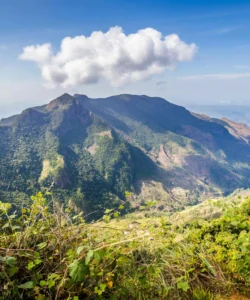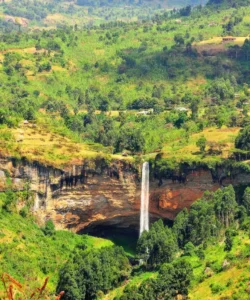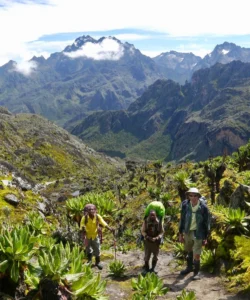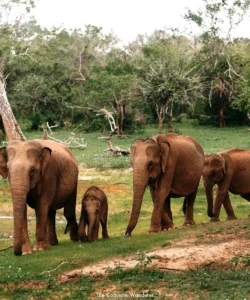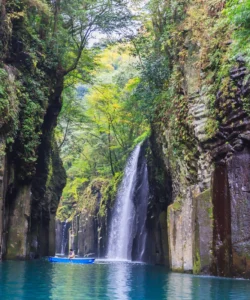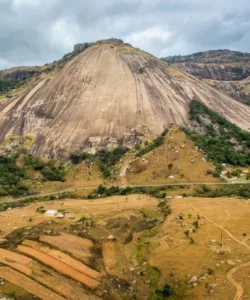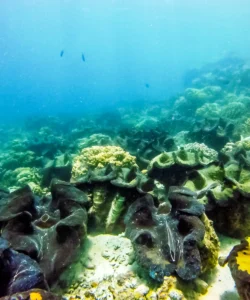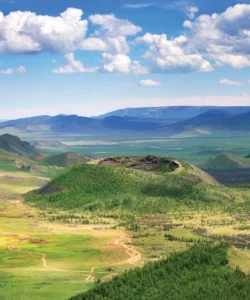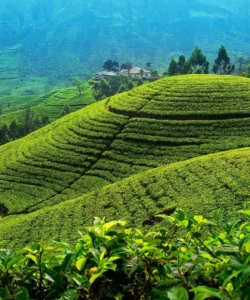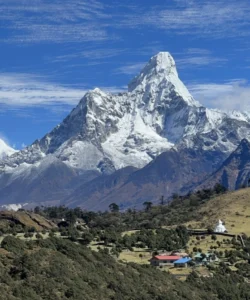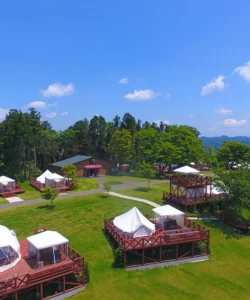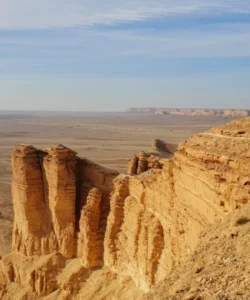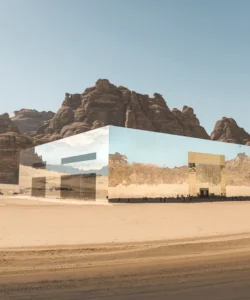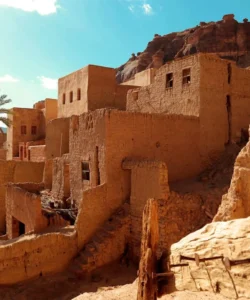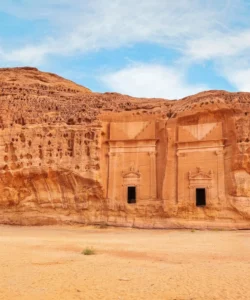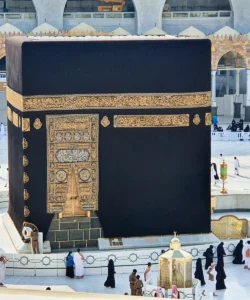Jigme Dorji National Park (JDNP) is an immense and incredibly significant natural wonder located in the Himalayas of northwestern Bhutan. Named in memory of the late Third King, Jigme Dorji Wangchuck, it stands as the second-largest national park in Bhutan and one of the richest in terms of both cultural and biological diversity.
Name: Jigme Dorji National Park (Dzongkha: འཇིགས་མེད་རྡོ་རྗེ་རྒྱལ་ཡོངས་གླིང་ག)
Address: Jigme Dorji National Park spans across most of the mountainous Gasa District and includes parts of Paro, Punakha, Thimphu, and Wangdue Phodrang districts in northwestern Bhutan. It borders Tibet (China) to the north.
How to Get There:
Access to Jigme Dorji National Park, like all travel in Bhutan, must be arranged through a licensed Bhutanese tour operator. The park is vast, and various entry points and trekking routes exist.
- By Air to Paro (PBH): The most common entry point into Bhutan is Paro International Airport (PBH), the country’s only international airport. From Paro, your tour operator will arrange ground transport.
- By Road from Paro/Thimphu/Punakha: The park’s boundaries are accessible by road from major towns. For instance, from Thimphu, you can drive towards Dodena (approximately 13 km) for a scenic approach. Roads connect to entry points in Punakha or Gasa (about 3-4 hours drive from Thimphu).
- Trekking (Recommended for full experience): To truly experience the heart of the park, trekking is essential. JDNP is famous for several world-class trekking routes, including:
- Jomolhari Trek: A popular multi-day trek (often 7-10 days) that goes to the base of sacred Mount Jomolhari.
- Laya-Gasa Trek: A challenging trek through high mountain passes and isolated villages.
- Snowman Trek: Often considered one of the most difficult and remote treks in the world, traversing very high passes and taking several weeks.
- These treks allow you to enter and explore various ecosystems within the park. Your tour operator will arrange guides, porters, and all necessary permits.
- Permits: Special permits are mandatory for foreign visitors to enter Bhutan and to undertake treks or visit certain restricted areas within Jigme Dorji National Park. These are handled by your licensed tour operator.
- Best Time to Visit: The best times for trekking and wildlife viewing are during the spring (March to May) and autumn (September to November) seasons. The weather is generally clear and dry, offering the best mountain views. Winter (December to February) can be very cold at high altitudes but offers exceptionally clear skies for snow leopard sightings. The monsoon (June to August) brings heavy rains and leeches, making trekking challenging.
Landscape and Architecture:
Jigme Dorji National Park boasts an astonishingly diverse landscape, encompassing a full spectrum of Himalayan ecosystems. Its “architecture” is a mix of natural grandeur and traditional Bhutanese structures, deeply integrated into the environment.
- Dramatic Altitudinal Range: The park spans an incredible altitudinal range, from approximately 1,400 meters (4,593 feet) at its lowest subtropical forests to 7,326 meters (24,035 feet) at the summit of Mount Jomolhari. This creates a remarkable vertical stratification of ecosystems.
- Towering Himalayan Peaks: JDNP is home to some of Bhutan’s most iconic and sacred mountains, including:
- Mount Jomolhari (7,326 m / 24,035 ft): Known as the “Bride of Kangchenjunga,” it’s the park’s highest point and a sacred peak to Tibetan Buddhists.
- Mount Jitchu Drake (6,662 m / 21,857 ft): Another sacred peak.
- Tsherim Kang (6,532 m / 21,430 ft).
- Glaciers and Glacial Lakes: The park contains over 376 glaciers (comprising 42.44% of Bhutan’s glaciers) and numerous pristine high-altitude glacial lakes, formed by melting ice, which contribute to its stunning alpine scenery and serve as headwaters for major rivers.
- Diverse Ecosystems: JDNP encompasses four major ecosystems:
- Warm Broadleaf Forests: At lower elevations.
- Cool Broadleaf Forests: Including species like spruce, fir, maple, and hemlock, often interspersed with rhododendrons.
- Mixed Coniferous Forests: Featuring various pine species.
- Alpine Meadows (Rangelands): Vast open grasslands that burst with wildflowers in summer, transitioning to barren rock and snow at the highest elevations.
- Rivers and Waterfalls: The park is the watershed for four of western Bhutan’s major river systems (Pho Chhu, Mo Chhu, Paro Chhu, and Wang Chhu), which originate from its glaciers and carve deep gorges and create cascading waterfalls.
- Hot Springs: JDNP is Bhutan’s only national park with a significant number of hot springs and medicinal baths (e.g., Gasa Hot Springs), offering therapeutic relaxation amidst the wilderness.
- Traditional Bhutanese Architecture (Dzongs and Monasteries): The park is not just natural wilderness; it also protects a rich cultural heritage:
- Lingshi Dzong (4,150 m): A historic Drukpa Kagyu monastery and fortress, housing monks, offering breathtaking mountain views.
- Gasa Dzong (2,850 m): An important administrative center and fortress with 17th-century architecture, originally built to repel invasions.
- Scattered smaller monasteries, stupas (chortens), and traditional stone houses of local communities are integrated into the landscape.
- Semi-Nomadic Villages: The park is home to several isolated communities of semi-nomadic people, like the Layap and Lunana communities, who practice traditional pastoralism (yak herding) and subsistence farming, living in harmony with nature and preserving distinct cultures and dialects. Their traditional bamboo or stone houses are adapted to the high-altitude environment.
What Makes It Famous:
- “Roof of Bhutan” / Second Largest Park: It is the second-largest national park in Bhutan, covering a massive area that stretches across the entire northwestern part of the country, encompassing Bhutan’s highest peaks.
- Only Park with Tiger and Snow Leopard Overlap: JDNP is uniquely famous as the only park in the world where the Royal Bengal Tiger (a lowland species) and the Snow Leopard (a high-altitude species) are known to share a habitat. This remarkable coexistence is a testament to its ecological diversity and significance. Camera traps have documented tigers at altitudes of 4,200 masl, the highest recorded in any tiger range country.
- Home to all “National Symbols”: It’s the only park in Bhutan where you can find all four of Bhutan’s national symbols: the national animal (Takin), the national flower (Blue Poppy), the national bird (Raven), and the national tree (Cypress). This makes it a microcosm of Bhutanese natural heritage.
- Concentration of Critically Endangered Species: It provides a critical safe haven for numerous globally endangered and vulnerable species of flora and fauna, including the snow leopard, Bengal tiger, Bhutan Takin (Bhutan’s national animal), Himalayan musk deer, red panda, Asiatic wild dog, Himalayan blue sheep, and Himalayan monal.
- Trekker’s Paradise: JDNP is aptly called the “trekker’s paradise” in Bhutan, offering some of the most challenging and scenic multi-day treks in the world (like the Jomolhari Trek and the Snowman Trek), attracting serious adventurers.
- Cultural and Natural Harmony: The park is also famous for its unique blend of cultural and biological diversity, showcasing centuries of harmonious coexistence between indigenous communities (Layap, Lunana) and the pristine wilderness.
- Headwaters for Major Rivers: It’s the source of four major river systems in western Bhutan, crucial for the country’s hydrology and downstream communities.
- Hot Springs and Medicinal Baths: The presence of numerous hot springs, some with medicinal properties, adds a unique natural amenity for trekkers.
- Tentative UNESCO World Heritage Site: It is currently on Bhutan’s tentative list for UNESCO World Heritage status, recognizing its outstanding universal value.
Differences from Some Other Wonders:
- Tiger-Snow Leopard Habitat Overlap: This is arguably its most significant and unique ecological distinction globally. While other parks might have tigers (Jim Corbett, Sundarbans, Chitwan) or snow leopards (Sagarmatha, Deosai), JDNP is the only place documented where their habitats are known to overlap, making it a unique conservation success and a scientific marvel.
- Comprehensive “National Symbols” Collection: Its unique status as the only place where all of Bhutan’s specific national symbols (animal, flower, bird, tree) can be found makes it a microcosm of the country’s natural identity.
- Broad Altitudinal Range within a Single Park: While other mountain parks span altitudes, JDNP’s extreme range from subtropical (1,400m) to permanent ice/snow (7,326m) means it encompasses a wider variety of ecosystems (warm broadleaf, cool broadleaf, mixed coniferous, alpine meadows) than most single national parks, providing a unique ecological gradient.
- Integration of Sacred Mountains and Historic Dzongs: Beyond natural features, JDNP includes culturally significant sacred mountains (Jomolhari, Jitchu Drake) and historic fortress-monasteries (Lingshi Dzong, Gasa Dzong) within its boundaries, making it a powerful blend of natural and cultural heritage, a feature less common in purely natural parks.
- Semi-Nomadic Pastoralist Communities: The presence of unique semi-nomadic indigenous communities like the Layap and Lunana within the park, practicing traditional yak herding and subsistence farming, highlights a distinct human-nature relationship compared to other conservation areas.
- Source of Major Rivers: Its role as the primary watershed for four of Bhutan’s most important rivers is a crucial hydrological feature, distinguishing it from parks with smaller or less significant river systems.
- No Self-Guided Access: Similar to Ulu Temburong National Park, JDNP operates under Bhutan’s strict tourism policy, requiring all foreign visitors to travel with a licensed tour operator and guides, emphasizing low-impact, controlled access.
Jigme Dorji National Park Photos:
[envira-gallery id=”17300″]

